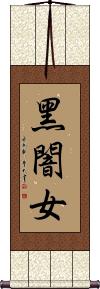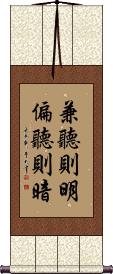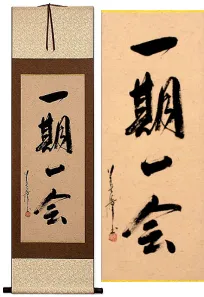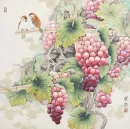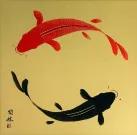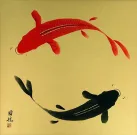Many custom options...
And formats...

The name Dark One in Chinese / Japanese...
Buy a Dark One calligraphy wall scroll here!
Personalize your custom “Dark One” project by clicking the button next to your favorite “Dark One” title below...
Dark Sister
黑闇女 is a Buddhist title that means “dark sister,” “dark one,” or “dark woman.”
There are two sisters:
One is the deva, 功德女 (“merit” or “achieving”), who causes people to acquire wealth.
The other is the “dark one,” 黑闇女, which causes people to spend and waste.
These sisters always accompany each other.
Listen to Both Sides and be Enlightened, Listen to One Side and be in the Dark
兼聽則明偏聽則暗 is an ancient Chinese proverb about getting all the information from all sides so that you truly understand a situation.
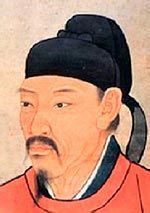
Wei Zheng
A man named Wei Zheng lived between 580-643 AD. He was a noble and wise historian and minister in the court of the early Tang Dynasty. The emperor once asked him, “What should an emperor do to understand the real-world situation, and what makes an emperor out-of-touch with reality?”
Wei Zheng replied, “Listen to both sides and you will be enlightened; listen to only one side and you will be left in the dark.”
Then Wei Zheng went on to cite examples of leaders in history that were victorious after heeding both sides of the story, and other leaders that met their doom because they believed one-sided stories which often came from flattering lips.
Please note that there is an unwritten rule when the same character appears twice in the same phrase, the calligrapher will alter the appearance so that no two characters are exactly alike in the same piece. This calligraphy has two repeating characters that will be written differently than they appear here.
This in-stock artwork might be what you are looking for, and ships right away...
Gallery Price: $72.00
Your Price: $39.88
Gallery Price: $90.00
Your Price: $49.88
Gallery Price: $340.00
Your Price: $188.77
Gallery Price: $200.00
Your Price: $122.88
Gallery Price: $108.00
Your Price: $59.88
Not the results for dark one that you were looking for?
Below are some entries from our dictionary that may match your dark one search...
| Characters If shown, 2nd row is Simp. Chinese |
Pronunciation Romanization |
Simple Dictionary Definition |
二女 see styles |
èr nǚ er4 nv3 erh nü nijo にじょ |
second daughter The two sisters, one the deva 功德女 "merit" or "achieving", who causes people to acquire wealth; the other, 黑闇女 the "dark" one, who causes them to spend and waste; these sisters always accompany each other. |
十二 see styles |
shí èr shi2 er4 shih erh tooji とおじ |
twelve; 12 12; twelve; (given name) Tooji dvātriṃśa. Thirty-two. 三十二應 (or 三十二身) The thirty-two forms of Guanyin, and of Puxian, ranging from that of a Buddha to that of a man, a maid, a rakṣas; similar to the thirty-three forms named in the Lotus Sūtra. 三十二相三十二大人相 dvātriṃśadvaralakṣaṇa. The thirty-two lakṣaṇas, or physical marks of a cakravartī, or 'wheel-king', especially of the Buddha, i. e. level feet, thousand-spoke wheel-sign on feet, long slender fingers, pliant hands and feet, toes and fingers finely webbed, full-sized heels, arched insteps, thighs like a royal stag, hands reaching below the knees well-retracted male organ, height and stretch of arms equal, every hair-root dark coloured, body hair graceful and curly, golden-hued body, a 10 ft. halo around him, soft smooth skin, the 七處, i. e. two soles, two palms, two shoulders, and crown well rounded, below the armpits well-filled, lion-shaped body, erect, full shoulders, forty teeth, teeth white even and close, the four canine teeth pure white, lion-jawed, saliva improving the taste of all food, tongue long and broad, voice deep and resonant, eyes deep blue, eyelashes like a royal bull, a white ūrnā or curl between the eyebrows emitting light, an uṣṇīṣa or fleshy protuberance on the crown. These are from the 三藏法數 48, with which the 智度論 4, 涅盤經 28, 中阿含經, 三十ニ相經 generally agree. The 無量義經 has a different list. 三十二相經 The eleventh chapter of the 阿含經. 三十二相經願 The twenty-first of Amitābha's vows, v. 無量壽經. 三十三 trayastriṃśat. Thirty-three. 三十三天忉利天; 憺梨天, 多羅夜登陵舍; 憺利夜登陵奢; 憺利耶憺利奢 Trayastriṃśas. The Indra heaven, the second of the six heavens of form. Its capital is situated on the summit of Mt. Sumeru, where Indra rules over his thirty-two devas, who reside on thirty-two peaks of Sumeru, eight in each of the four directons. Indra's capital is called 殊勝 Sudarśana, 喜見城 Joy-view city. Its people are a yojana in height, each one's clothing weighs 六鐵 (1; 4 oz. ), and they live 1, 000 years, a day and night being equal to 100 earthly years. Eitel says Indra's heaven 'tallies in all its details with the Svarga of Brahminic mythology' and suggests that 'the whole myth may have an astronomical meaning', or be connected, with 'the atmosphere with its phenomena, which strengthens Koeppen's hypothesis explaining the number thirty-three as referring to the eight Vasus, eleven Rudras, twelve Ādityas, and two Aśvins of Vedic mythology'. In his palace called Vaijayanta 'Indra is enthroned with 1, 000 eyes with four arms grasping the vajra. There he revels in numberless sensual pleasures together with his wife Śacī... and with 119, 000 concubines with whom he associates by means of transformation'.; dvādaśa, twelve. |
十心 see styles |
shí xīn shi2 xin1 shih hsin jisshin |
The ten kinds of heart or mind; there are three groups. One is from the 止觀 4, minds ignorant and dark; affected by evil companions; not following the good; doing evil in thought, word, deed; spreading evil abroad; unceasingly wicked; secret sin; open crime; utterly shameless; denying cause and effect (retribution)―all such must remain in the flow 流 of reincarnation. The second group (from the same book) is the 逆流 the mind striving against the stream of perpetual reincarnation; it shows itself in devout faith, shame (for sin), fear (of wrong-doing), repentance and confession, reform, bodhi (i.e. the bodhisattva mind), doing good, maintaining the right law, thinking on all the Buddhas, meditation on the void (or, the unreality of sin). The third is the 眞言 group from the 大日經疏 3; the "seed" heart (i.e. the original good desire), the sprout (under Buddhist religious influence), the bud, leaf, flower, fruit, its serviceableness; the child-heart, the discriminating heart, the heart of settled judgment (or resolve). |
紺珠 see styles |
kanju かんじゅ |
dark blue gem allowing one to recall memories when stroked with one's hand (allegedly possessed by Zhang Yue) |
手弄り see styles |
temasaguri てまさぐり |
(noun/participle) (1) playing with something with one's fingers; (2) searching with one's fingers (e.g. in the dark) |
熊貓眼 熊猫眼 see styles |
xióng māo yǎn xiong2 mao1 yan3 hsiung mao yen |
to have dark circles under one's eyes; to have eyes like a panda |
重屏禁 see styles |
juuheikin / juhekin じゅうへいきん |
solitary confinement in a dark cell without bedding (for up to one week) |
黑眼圈 see styles |
hēi yǎn quān hei1 yan3 quan1 hei yen ch`üan hei yen chüan |
dark circles (under one's eyes); black eye |
黒歴史 see styles |
kurorekishi くろれきし |
(net-sl) dark history; dark past; something one wants to forget or pretend never happened |
不遇時代 see styles |
fuguujidai / fugujidai ふぐうじだい |
one's dark days; the period during which one suffered misfortune and obscurity |
十二火天 see styles |
shí èr huǒ tiān shi2 er4 huo3 tian1 shih erh huo t`ien shih erh huo tien jūnikaten |
The homa-, or fire-spirits; Whose representations, colours, magic words, signs, symbols, and mode of worship are given in the 大日經疏20. Also 十二火尊; 十二種火法. The twelve fire-spirits are: (1) Indra or Vairocana, the discoverer or source of fire, symbolizing 智 knowledge; (2) the moon 行滿 which progresses to fullness, with mercy as root and enlightenment as fruit, i,e. Buddha; (3) the wind, represented as a half-moon, fanner of fame, of zeal, and by driving away dark clouds, of enlightenment; (4) the red rays of the rising sun, rohitaka, his swords (or rays) indicating 議 wisdom; (5) 沒M004101拏 a form half stern, half smiling, sternly driving away the passions and trials; (6) 忿怒 irate, bellowing with open mouth, showing four teeth, flowing locks, one eye closed; (7) 闍吒羅 fire burning within, i.e. the inner witness, or realization; (8) 迄灑耶 the waster, or destroyer of waste and injurious products within, i.e. inner purification; (9) 意生 the producer at will, capable of all variety, resembling Viśvakarman, the Brahmanic Vulcan; (10) 羯羅微 the fire-eater; (11) untraceable; (12) 謨賀那 the completer, also the subduer of demons. |
棄暗投明 弃暗投明 see styles |
qì àn tóu míng qi4 an4 tou2 ming2 ch`i an t`ou ming chi an tou ming |
to renounce the dark and seek the light; to give up one's wrong way of life and turn to a better one |
闇に鉄砲 see styles |
yaminiteppou / yaminiteppo やみにてっぽう |
(exp,n) (idiom) doing something without having decided what one's goal for it is; a rifle in the dark |
手まさぐり see styles |
temasaguri てまさぐり |
(noun/participle) (1) playing with something with one's fingers; (2) searching with one's fingers (e.g. in the dark) |
一條路走到黑 一条路走到黑 see styles |
yī tiáo lù zǒu dào hēi yi1 tiao2 lu4 zou3 dao4 hei1 i t`iao lu tsou tao hei i tiao lu tsou tao hei |
lit. to follow one road until dark (idiom); fig. to stick to one's ways; to cling to one's course |
一髻羅刹王菩薩 一髻罗刹王菩萨 see styles |
yī jì luó chà wáng pú sà yi1 ji4 luo2 cha4 wang2 pu2 sa4 i chi lo ch`a wang p`u sa i chi lo cha wang pu sa ikkeirasetsu ō bosatsu |
The four-handed, dark-blue rakṣaḥ with the flame of fire coming out of his head, a bodhisattva in the Garbhadhātu maṇḍala. |
Variations: |
temasaguri てまさぐり |
(noun/participle) (1) playing with something with one's fingers; (noun/participle) (2) searching with one's fingers (e.g. in the dark) |
暗がりから牛を引き出す see styles |
kuragarikaraushiohikidasu くらがりからうしをひきだす |
(exp,v5s) (idiom) to drive black hogs in the dark; to be unable to distinguish one thing from another; to come out from the darkness with a cow |
The following table may be helpful for those studying Chinese or Japanese...
| Title | Characters | Romaji (Romanized Japanese) | Various forms of Romanized Chinese | |
| Dark Sister | 黑闇女 | koku an nyo kokuannyo | hēi àn nǚ hei1 an4 nv3 hei an nv heiannv | hei an nü heiannü |
| Listen to Both Sides and be Enlightened, Listen to One Side and be in the Dark | 兼聽則明偏聽則暗 兼听则明偏听则暗 | jiān tīng zé míng, piān tīng zé àn jian1 ting1 ze2 ming2, pian1 ting1 ze2 an4 jian ting ze ming, pian ting ze an | chien t`ing tse ming, p`ien t`ing tse an chien ting tse ming, pien ting tse an |
|
| In some entries above you will see that characters have different versions above and below a line. In these cases, the characters above the line are Traditional Chinese, while the ones below are Simplified Chinese. | ||||
Successful Chinese Character and Japanese Kanji calligraphy searches within the last few hours...
